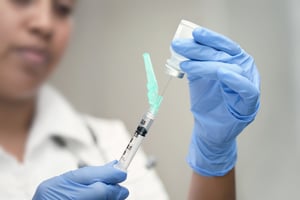 The annual flu season is just around the corner and as an EMT or paramedic you are more than likely to come in contact with someone who has the flu. This is especially true considering information released by the CDC shows a gradual increase that indicates the 2018-2019 season is almost upon us. It's time to get your flu shot if you haven't already done so, since you are the first line of infection prevention.
The annual flu season is just around the corner and as an EMT or paramedic you are more than likely to come in contact with someone who has the flu. This is especially true considering information released by the CDC shows a gradual increase that indicates the 2018-2019 season is almost upon us. It's time to get your flu shot if you haven't already done so, since you are the first line of infection prevention.
Changes to the Flu Vaccine in 2018-2019
This year, most vaccines will be quadrivalent. The FDA and WHO believe the four most likely flu virus strains will be linked to:
- A/Michigan/45/2015 (H1N1)
- A/Singapore/ INFIMH-16-0019/2016A (H3N2)
- B/Colorado/06/2016
- B/Phuket/3073/2013
Changes in vaccines for the coming season included altering the B/Victoria to B/Colorado and updating the H3N2 component. The different types of vaccine available include:
- Nasal spray vaccine
- Regular dosage egg-based flu shots
- Recombinant vaccine shots
- Cell-grown vaccine shots
It's recommended you get flu shots before influenza starts spreading in your area. Bear in mind it takes approximately two weeks for flu antibodies to develop.
Control Infection by Preventing Infection
The best way to reduce the spread of influenza is to prevent being infected. Because EMTs and paramedics are in frequent contact with sick or injured patients, they're naturally susceptible to airborne infections such as flu viruses that spread through respiratory secretions. That's why it's important you take steps to protect yourself from infection by taking proper precautions and being vaccinated. In that way, you avoid being a conduit spreading infection and unwittingly contributing towards exacerbating an epidemic.
Key Personal Protection Measures Against Influenza
Virus-containing droplets exhaled by sick patients land on nearby surfaces, and as these droplets evaporate, water vapor spreads the virus. Because influenza viruses can survive for between 24 and 48 hours on hard surfaces, the risk of infection remains after patients are moved.
There are several steps EMS personnel can take to minimize the risk of becoming infected as well as protecting patients. The obvious step of being immunized against influenza reduces the risk of picking up flu and passing the infection onto patients. It's also important to be aware of possible exposure to patients exhibiting flu-like symptoms. When necessary, wear a filtration mask and make sure you have no open cuts or wounds. Wear eye protection if there's a possibility of contact with airborne secretions.
Have an infection control plan, and regularly clean your equipment, including grab rails, stretchers, and treatment equipment. Keep the interior of your ambulance and the cabin clean by wiping down surfaces with a disinfectant. Washing or disinfecting your hands frequently minimizes the risk of picking up and transmitting viruses.
Protection of Immunocompromised Patients
Immunocompromised patients have a limited ability to resist infections. It's vital you take additional precautions when you attend to and transport such patients. This covers using respirator masks and ensuring your equipment is clean and sterile. Also, avoid unnecessary drafts and separate patients to avoid cross infection.
Although Graham Medical's infection prevention products help minimize the risk of infection, it's important to remember infection prevention starts with you. Taking the flu vaccine early helps you avoid falling ill and reduces the risk of transmitting a flu infection to your patients. Keep up to date with this and other topics by subscribing to our blog.

